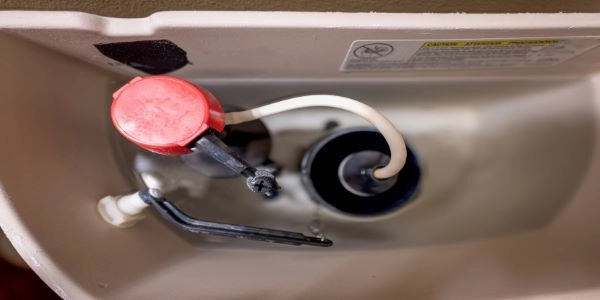
Mr. Rooter Plumbing explains how replacing your toilet flapper can lower your water bill.
|
Do you often feel like you’re flushing your hard-earned money down the toilet every time you pay your water bill? Well, you might be doing just that. It may surprise you to learn that a leaky toilet is the number one cause of rising water bills. In fact, a faulty toilet can waste up to a gallon of water per day.
When you add this up, that’s over 30 gallons of wasted water a month or 360 gallons a year. That’s a lot of wasted water! And what’s the most common culprit when it comes to water-wasting toilets? A small, plug-like contraption called a toilet flapper. Below, you can learn how to replace a toilet flapper and why it can be a good idea to consider replacing it sooner rather than later!
What Is a Toilet Flapper?
So, what exactly IS a toilet flapper? It’s a rubber, plug-like device at the bottom of the toilet tank attached to the tank lever by a chain. The toilet flapper, also known as a commode flapper, helps maintain a consistent water level and ensures enough water in your tank to flush the toilet when needed. Although it’s not a sophisticated device, the flapper ensures your toilet works correctly and efficiently.
How Does a Toilet Flapper Work?
If you’ve ever had to flush your toilet manually, you’ve seen how simple the inner workings of your toilet are. When you flush, the flush lever pulls the chain, lifts the flapper, and releases the water from the tank. Once the water drains from the tank, the float ball drops and activates a fill valve that triggers new water flow back into the tank.
This simple process gets interrupted if the flapper is damaged, frayed, broken, or faulty. If the flapper doesn’t create a proper seal, water will leak from the tank, forcing the float ball to drop, which activates the fill valve...you see where this is going? A faulty flapper means your toilet tank will empty and fill up repeatedly. This constant filling and refilling of the tank over days or weeks can result in a lot of wasted water—and wasted money. When this happens, it’s time to replace your toilet flapper and put a stop to all that waste.
Related Topic: Toilet Leaking at the Base? This Could Be the Problem
How to Choose the Right Toilet Flapper Size
Although toilets come in several different shapes and sizes, there’s less variety for toilet flappers. However, ensuring you have the correct size flapper for your toilet is vital, especially when your goal is to conserve water and save money!
Luckily, figuring out the right size flapper for your toilet is pretty simple. Flappers typically come in two different sizes: two-inch and three-inch. Most toilets will use a two-inch flapper, while newer toilets (those made after 2005) generally use a three-inch flapper.
You can determine the right flapper size for your toilet by looking at the size of the flush valve drain opening at the bottom of the tank. The flush valve drain is the opening that leads from your toilet tank to your plumbing. If it looks around the same as a baseball or orange, it will most likely require a two-inch flapper. A three-inch flapper is needed if the opening is more like a softball or a grapefruit.
When to Replace Your Toilet Flapper
Most people wait until their toilet is leaking, not flushing, or hissing at them before performing any type of maintenance. But a little preventative maintenance can help you avoid costly water bills!
Determining when to replace your toilet flapper is as easy as listening and looking. If you walk past the bathroom and hear your tank filling with water and the toilet hasn’t been flushed recently, lift the tank lid and inspect the flapper for damage or signs of wear.
If the flapper looks good, check to see if the chain is tangled or getting caught on something when the toilet is flushed. However, if the flapper looks damaged or doesn’t completely cover the drain valve opening, it’s probably time to replace it.
Can You Repair a Toilet Flapper?
We’re a nation of DIYers, so performing a toilet flapper repair might be something you consider before spending money on new plumbing products. While you can perform a type of commode flapper repair simply by cleaning away mineral buildup, toilet flapper replacement is often a better option.
Remember, even though the flapper is made of rubber and designed to function underwater, constant submersion will eventually warp and fray its edges. As a result, a flapper will last about two years before you need to replace it with a new one.
Contact the Toilet Flapper Pros – Mr. Rooter Plumbing®
Although we use our toilets every day, we don’t often think about what they need to function efficiently. We just expect that when we need them, they’ll work correctly and without fail.
But now that you’re a flapper expert and understand some of the possible causes of your rising water bill, you should be able to take the steps necessary to fix the problem. Replacing your toilet flapper isn’t a difficult job, but if it’s not done correctly, it could lead to more wasted water and expensive water bills!
If you require toilet flapper replacement and you’re not sure where to begin, contact the plumbing pros at your local Mr. Rooter Plumbing®. We have the knowledge and experience to replace your toilet flapper and perform many other maintenance and repair services to meet all your plumbing needs.

